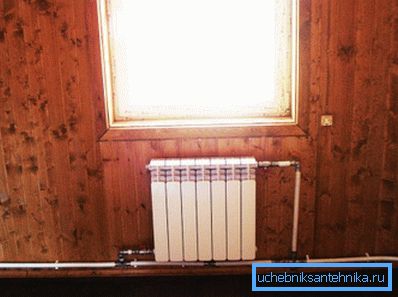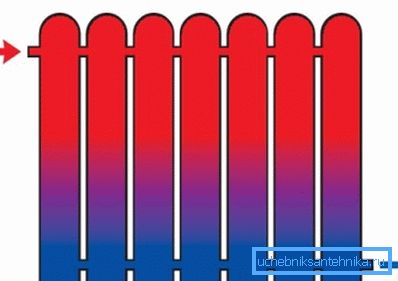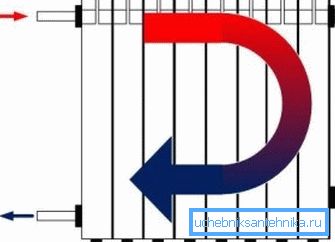Connecting radiators in a single pipe system. cross, saddle,
Heating networks in private and multi-family houses have been organized for a long time. Quite often, a one-pipe connection of radiators, involving the serial connection of devices, takes place. This option is most effective when using the natural circulation of the coolant.

Pros and cons of solutions
When constructing such heating networks, the supply pipe from the boiler is fed directly to the first battery, and from it to the second, third and others. The working environment enters the devices in turn.
If the house is connected radiators with one-pipe heating system, we can talk about the following advantages and disadvantages.
The main advantages
- The low price of the finished network is explained by the minimal consumption of the elements used;
- Down pipelines are quite easy to hide, as they are located in a single line;
- The structure of the system is quite simple, and this makes it possible to build it with your own hands;
- This type of heating network can function without forced circulation.

Certain disadvantages
- There is no possibility to adjust the flow of the working environment in the heating devices;
- Such systems are not recommended if the length of the pipelines is very large;
- Replacement or repair of batteries in any case will have to be done with a complete stop of the communication network.
Addition! When a radiator is connected to a one-pipe system, up to 50 percent of the budget can be saved on pipelines when compared to a two-pipe communication network.
Basic connection options
The connection of heating devices can be done in several ways. The level of heat losses as well as aesthetic characteristics will depend on the choice of a particular one. In total there are four basic options, all of them should be considered in more detail.
Cross Location
The most effective in terms of heat output is a diagonal connection of a heating radiator with a one-pipe system. The coolant enters the upper compartment of the battery, and comes directly from the bottom. With this option, it is distributed as evenly as possible throughout the structure.

Seat Connection
In this case, the pipeline is connected to the lower connections of the device on each side. With this method of installation, heat loss increases to some extent. However, the location of the elements can be considered advantageous if we talk about aesthetic possibilities.

One-way connection
This technique involves the location of elements on the one hand, but at different levels. That is, the supply pipeline is at the top, and the discharge pipe is at the bottom. Thus, it is possible to fully heat the last device.

Lower accommodation
Such a scheme for connecting radiators with a single-pipe system is relevant if the conductive elements are hidden under the floor. Without the installation of a circulation pump, this method cannot be implemented, since the coolant is supplied and discharged through the bottom.

Installation work
After getting acquainted with the battery connection options, it’s time to learn about their installation and subsequent connection to the pipelines. All actions are quite realistic to do on their own, refusing to attract professionals. This allows significant savings.
Installation of instruments
Before connecting radiators with a single-pipe heating system, they must be installed. They can be fixed both to the side surfaces and to the lower part of the room.
Detailed installation instructions are presented below:
- The installation locations of brackets or hooks are marked first.. During the work using a tape measure and a simple pencil. The device should be at least 8 cm apart from the floor, about 10 cm from the window sill and more than 2 cm from the wall;
- After applying the markup, the dowels are installed.. To do this, a hole is drilled in reinforced concrete that corresponds to fasteners. If the side plane is made of wood, then fixing is carried out by screws;
- At the very last stage, the parts are fixed in a certain place, after which a properly prepared battery is hung on them.. Usually for one device you need to install 2-3 hooks or brackets.

Attention! After installing the fasteners, their reliability is tested. Holders should not move relative to the horizontal and vertical or bend under the action of the applied efforts.
Connection process
The binding of heating devices can actually be carried out using elements made of various materials, but polypropylene has recently become more popular. Therefore, below is considered an option with pipes from this high-molecular compound.
After installation of the shut-off and control valves, a special coupling is installed, which is necessary for joining with polypropylene products. The pipes are joined to it by soldering.
When performing thermal docking, you should adhere to a certain warm-up time. It should fluctuate within 5-20 seconds. Overheating of parts can cause damage.
The seam is seized within 3 minutes, so care must be taken during this time, otherwise the elements may twist or fall off completely.

Useful recommendations
- Despite the simplicity of the communication network of this type, it is necessary to carry out a detailed project with preliminary calculations before carrying out the main works;
- To arrange the conductive elements in arbitrary locations, it is imperative to install a circulation pump that will force the coolant to move in a closed loop;
- The pipelines made of polypropylene need to be fixed to the side surface with compensating supports. They allow to fix products in one position, but at the same time linear movement remains possible;
- If metal analogs are used instead of polypropylene elements, then docking is carried out by means of special fittings or welding;
- If desired, pipelines can be laid in the wall, which will positively affect the aesthetic perception of the room. You can also make a decorative box that will hide conductive products;
- To reduce heat losses, it is not recommended to locate the radiators of the heating system in a niche or any openings, especially if the efficiency of the entire network is not very high;
- In the presence of a circulating device, it is desirable to acquire a backup power source, since the heating will not function when the electricity is turned off;
- Fixing batteries with floor holders is recommended if the walls are made of lightweight materials. In other cases, special hooks should be mounted.
Final part
The above information will provide an opportunity for beginners to make the correct connection of radiators with a single pipe system in a private house or apartment.
During installation, you can use any of the proposed schemes for the connection of conductive elements. As for the special video in this article, it will allow you to visually get acquainted with this topic.